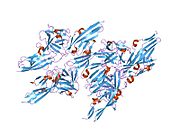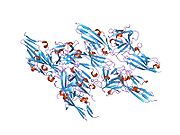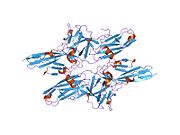- Fibroblast growth factor receptor 2
-
Fibroblast growth factor receptor 2 (FGFR2) also known as CD332 (cluster of differentiation 332) is a protein that in humans is encoded by the FGFR2 gene residing on chromosome 10.[1][2] FGFR2 is a receptor for fibroblast growth factor.
The protein encoded by this gene is a member of the fibroblast growth factor receptor family, where amino acid sequence is highly conserved between members and throughout evolution.[3] FGFR family members differ from one another in their ligand affinities and tissue distribution. A full-length representative protein consists of an extracellular region, composed of three immunoglobulin domains, a single hydrophobic membrane-spanning segment and a cytoplasmic tyrosine kinase domain. The extracellular portion of the protein interacts with fibroblast growth factors, setting in motion a cascade of downstream signals, ultimately influencing mitogenesis and differentiation. This particular family member is a high-affinity receptor for acidic, basic and/or keratinocyte growth factor, depending on the isoform.
Contents
Isoforms
FGFR2 has two naturally occurring isoforms FGFR2IIIb and FGFR2IIIc, created by splicing of the third immunoglobulin-like domain. FGFR2IIIb is predominantly found in ectoderm derived tissues and endothelial organ lining, i.e. skin and internal organs.[4] FGFR2IIIc is found in mesenchyme, which includes craniofacial bone and for this reason the mutations of this gene and isoform are associated with craniosynostosis.
Interactions
Fibroblast growth factor receptor 2 has been shown to interact with FGF1.[5][6][7]
The spliced isoforms, however differ in binding:[8]
- FGFR2IIIb binds to FGF-1, -3, -7, -10, -22
- FGFR2IIIc binds to FGF-1, -2, -4, -6, -8, -9, -17 and -18
These differences in binding are not surprising, since FGF ligand is known to bind to the second and third immunoglobulin domain of the receptor.
Clinical significance
Mutations (changes) are associated with numerous medical conditions that include abnormal bone development (e.g. craniosynostosis syndromes) and cancer.
Craniosynostosis syndromes
- Apert syndrome, the best-known type of acrocephalosyndactyly. This condition is characterized by abnormalities of the skull and face and the hands and feet.
- Antley-Bixler syndrome (characterized by trapezoidal, craniofacial and skeletal synostosis, plus camptodactyly). Inherited as a recessive trait.
- Pfeiffer syndrome (another type of acrocephalosyndactyly). Inherited as a dominant trait, includes broad thumbs and large toes.
- Crouzon syndrome (a craniofacial disorder with no clinically significant hand or foot problems). Inherited as a dominant trait.
- Jackson-Weiss syndrome
Cancer
- Breast cancer, a mutation or single nucleotide polymorphism (SNP) in intron 2 of the FGFR2 gene is associated with a higher breast cancer risk; however the risk is only mildly increased from about 10% lifetime breast cancer risk in the average woman in the industrialized world, to 12-14% risk in carriers of the SNP.[9]
Function and mutations
FGFR2 has important roles in embryonic development and tissue repair, especially bone and blood vessels. Like the other members of the Fibroblast growth factor receptor family, these receptors signal by binding to their ligand and dimerisation (pairing of receptors), which causes the tyrosine kinase domains to initiate a cascade of intracellular signals. On a molecular level these signals mediate cell division, growth and differentiation.
As mentioned, FGFR2 mutations are associated with craniosynostosis syndromes, which are skull malformations caused by premature fusion of cranial sutures and other disease features according to the mutation itself. On a molecular level, mutations that affect FGFR2IIIc are associated with marked changes in osteoblast proliferation and differentiation.[10] Alteration in FGFR2 signalling is thought to underlie the craniosynostosis syndromes. To date, there are two mechanisms of altered FGFR2 signalling. The first is associated with constitutive activation of FGFR, where the FGFR2 receptor is always signalling, regardless of the amount of FGF ligand.[11] This mechanism is found in patients with Crouzon and Pfeiffer syndrome. The second, which is associated with Apert syndrome is a loss of specificity of the FGFR2 isoform, resulting in the receptor binding to FGFs that it does not normally bind.[12]
See also
References
- ^ Houssaint E, Blanquet PR, Champion-Arnaud P, Gesnel MC, Torriglia A, Courtois Y, Breathnach R (October 1990). "Related fibroblast growth factor receptor genes exist in the human genome". Proc. Natl. Acad. Sci. U.S.A. 87 (20): 8180–4. doi:10.1073/pnas.87.20.8180. PMC 54916. PMID 2172978. http://www.pubmedcentral.nih.gov/articlerender.fcgi?tool=pmcentrez&artid=54916.
- ^ Dionne CA, Crumley G, Bellot F, Kaplow JM, Searfoss G, Ruta M, Burgess WH, Jaye M, Schlessinger J (September 1990). "Cloning and expression of two distinct high-affinity receptors cross-reacting with acidic and basic fibroblast growth factors". EMBO J. 9 (9): 2685–92. PMC 551973. PMID 1697263. http://www.pubmedcentral.nih.gov/articlerender.fcgi?tool=pmcentrez&artid=551973.
- ^ "Entrez Gene: FGFR2 fibroblast growth factor receptor 2 (bacteria-expressed kinase, keratinocyte growth factor receptor, craniofacial dysostosis 1, Crouzon syndrome, Pfeiffer syndrome, Jackson-Weiss syndrome)". http://www.ncbi.nlm.nih.gov/sites/entrez?Db=gene&Cmd=ShowDetailView&TermToSearch=2263.
- ^ Orr-Urtreger A, Bedford MT, Burakova T, Arman E, Zimmer Y, Yayon A, Givol D, Lonai P (August 1993). "Developmental localization of the splicing alternatives of fibroblast growth factor receptor-2 (FGFR2)". Dev. Biol. 158 (2): 475–86. doi:10.1006/dbio.1993.1205. PMID 8393815.
- ^ Stauber DJ, DiGabriele AD, Hendrickson WA (January 2000). "Structural interactions of fibroblast growth factor receptor with its ligands". Proc. Natl. Acad. Sci. U.S.A. 97 (1): 49–54. doi:10.1073/pnas.97.1.49. PMC 26614. PMID 10618369. http://www.pubmedcentral.nih.gov/articlerender.fcgi?tool=pmcentrez&artid=26614.
- ^ Pellegrini L, Burke DF, von Delft F, Mulloy B, Blundell TL (October 2000). "Crystal structure of fibroblast growth factor receptor ectodomain bound to ligand and heparin". Nature 407 (6807): 1029–34. doi:10.1038/35039551. PMID 11069186.
- ^ Santos-Ocampo S, Colvin JS, Chellaiah A, Ornitz DM (January 1996). "Expression and biological activity of mouse fibroblast growth factor-9". J. Biol. Chem. 271 (3): 1726–31. doi:10.1074/jbc.271.3.1726. PMID 8576175.
- ^ Ornitz DM, Xu J, Colvin JS, McEwen DG, MacArthur CA, Coulier F, Gao G, Goldfarb M (June 1996). "Receptor specificity of the fibroblast growth factor family". J. Biol. Chem. 271 (25): 15292–7. doi:10.1074/jbc.271.25.15292. PMID 8663044.
- ^ Hunter DJ, Kraft P, Jacobs KB, et al. (2007). "A genome-wide association study identifies alleles in FGFR2 associated with risk of sporadic postmenopausal breast cancer". Nature Genetics 39 (7): 870–4. doi:10.1038/ng2075. PMID 17529973.
- ^ Lee KM, Santos-Ruiz L, Ferretti P (March 2010). "A single-point mutation in FGFR2 affects cell cycle and Tgfbeta signalling in osteoblasts". Biochim. Biophys. Acta 1802 (3): 347–55. doi:10.1016/j.bbadis.2009.11.006. PMID 20004243.
- ^ Webster MK, Donoghue DJ (October 1997). "Enhanced signaling and morphological transformation by a membrane-localized derivative of the fibroblast growth factor receptor 3 kinase domain". Mol. Cell. Biol. 17 (10): 5739–47. PMC 232422. PMID 9315632. http://www.pubmedcentral.nih.gov/articlerender.fcgi?tool=pmcentrez&artid=232422.
- ^ Hajihosseini MK, Duarte R, Pegrum J, Donjacour A, Lana-Elola E, Rice DP, Sharpe J, Dickson C (February 2009). "Evidence that Fgf10 contributes to the skeletal and visceral defects of an Apert syndrome mouse model". Dev. Dyn. 238 (2): 376–85. doi:10.1002/dvdy.21648. PMID 18773495.
Further reading
- McKeehan WL, Kan M (1995). "Heparan sulfate fibroblast growth factor receptor complex: structure-function relationships.". Mol. Reprod. Dev. 39 (1): 69–81; discusison 81–2. doi:10.1002/mrd.1080390112. PMID 7999363.
- Johnson DE, Williams LT (1993). "Structural and functional diversity in the FGF receptor multigene family.". Adv. Cancer Res. 60: 1–41. doi:10.1016/S0065-230X(08)60821-0. PMID 8417497.
- Park WJ, Meyers GA, Li X, et al. (1996). "Novel FGFR2 mutations in Crouzon and Jackson-Weiss syndromes show allelic heterogeneity and phenotypic variability.". Hum. Mol. Genet. 4 (7): 1229–33. doi:10.1093/hmg/4.7.1229. PMID 8528214.
- Marie PJ, Debiais F, Haÿ E (2003). "Regulation of human cranial osteoblast phenotype by FGF-2, FGFR-2 and BMP-2 signaling.". Histol. Histopathol. 17 (3): 877–85. PMID 12168799.
- Ibrahimi OA, Chiu ES, McCarthy JG, Mohammadi M (2005). "Understanding the molecular basis of Apert syndrome.". Plast. Reconstr. Surg. 115 (1): 264–70. PMID 15622262.
External links
- GeneReviews/NIH/NCBI/UW entry on FGFR-Related Craniosynostosis Syndromes
- MeSH Fibroblast+Growth+Factor+Receptor+2
PDB gallery 1djs: LIGAND-BINDING PORTION OF FIBROBLAST GROWTH FACTOR RECEPTOR 2 IN COMPLEX WITH FGF11e0o: CRYSTAL STRUCTURE OF A TERNARY FGF1-FGFR2-HEPARIN COMPLEX1ev2: CRYSTAL STRUCTURE OF FGF2 IN COMPLEX WITH THE EXTRACELLULAR LIGAND BINDING DOMAIN OF FGF RECEPTOR 2 (FGFR2)1gjo: THE FGFR2 TYROSINE KINASE DOMAIN1ii4: CRYSTAL STRUCTURE OF SER252TRP APERT MUTANT FGF RECEPTOR 2 (FGFR2) IN COMPLEX WITH FGF21iil: CRYSTAL STRUCTURE OF PRO253ARG APERT MUTANT FGF RECEPTOR 2 (FGFR2) IN COMPLEX WITH FGF21nun: Crystal Structure Analysis of the FGF10-FGFR2b Complex1oec: FGFR2 KINASE DOMAIN1wvz: Solution Structure of the D2 Domain of the Fibroblast Growth Factor2fdb: Crystal Structure of Fibroblast growth factor (FGF)8b in complex with FGF Receptor (FGFR) 2cProtein kinases: tyrosine kinases (EC 2.7.10) Receptor tyrosine kinases (EC 2.7.10.1) Insulin receptor familyPDGF receptor familyFGF receptor familyVEGF receptors familyHGF receptor familyTrk receptor familyEPH receptor familyLTK receptor familyLTK · ALKTIE receptor familyROR receptor familyROR1 · ROR2DDR receptor familyPTK7 receptor familyRYK receptor familyMuSK receptor familyROS receptor familyAATYK receptor familyAXL receptor familyRET receptor familyuncatagorisedNon-receptor tyrosine kinases (EC 2.7.10.2) ABL familyACK familyACK1 · TNK1CSK familyFAK familyFES familyFRK familyJAK familySRC-A familySRC-B familyTEC familySYK family1-50 CD1 (a-c, 1A, 1D, 1E) · CD2 · CD3 (γ, δ, ε) · CD4 · CD5 · CD6 · CD7 · CD8 (a) · CD9 · CD10 · CD11 (a, b, c) · CD13 · CD14 · CD15 · CD16 (A, B) · CD18 · CD19 · CD20 · CD21 · CD22 · CD23 · CD24 · CD25 · CD26 · CD27 · CD28 · CD29 · CD30 · CD31 · CD32 (A, B) · CD33 · CD34 · CD35 · CD36 · CD37 · CD38 · CD39 · CD40 · CD41 · CD42 (a, b, c, d) · CD43 · CD44 · CD45 · CD46 · CD47 · CD48 · CD49 (a, b, c, d, e, f) · CD5051-100 CD51 · CD52 · CD53 · CD54 · CD55 · CD56 · CD57 · CD58 · CD59 · CD61 · CD62 (E, L, P) · CD63 · CD64 (A, B, C) · CD66 (a, b, c, d, e, f) · CD68 · CD69 · CD70 · CD71 · CD72 · CD73 · CD74 · CD78 · CD79 (a, b) · CD80 · CD81 · CD82 · CD83 · CD84 · CD85 (a, d, e, h, j, k) · CD86 · CD87 · CD88 · CD89 · CD90 · CD91- CD92 · CD93 · CD94 · CD95 · CD96 · CD97 · CD98 · CD99 · CD100101-150 CD101 · CD102 · CD103 · CD104 · CD105 · CD106 · CD107 (a, b) · CD108 · CD109 · CD110 · CD111 · CD112 · CD113 · CD114 · CD115 · CD116 · CD117 · CD118 · CD119 · CD120 (a, b) · CD121 (a, b) · CD122 · CD123 · CD124 · CD125 · CD126 · CD127 · CD129 · CD130 · CD131 · CD132 · CD133 · CD134 · CD135 · CD136 · CD137 · CD138 · CD140b · CD141 · CD142 · CD143 · CD144 · CD146 · CD147 · CD148 · CD150151-200 CD151 · CD152 · CD153 · CD154 · CD155 · CD156 (a, b, c) · CD157 · CD158 (a, d, e, i, k) · CD159 (a, c) · CD160 · CD161 · CD162 · CD163 · CD164 · CD166 · CD167 (a, b) · CD168 · CD169 · CD170 · CD171 · CD172 (a, b, g) · CD174 · CD177 · CD178 · CD179 (a, b) · CD181 · CD182 · CD183 · CD184 · CD185 · CD186 · CD191 · CD192 · CD193 · CD194 · CD195 · CD196 · CD197 · CDw198 · CDw199 · CD200201-250 CD201 · CD202b · CD204 · CD205 · CD206 · CD207 · CD208 · CD209 · CDw210 (a, b) · CD212 · CD213a (1, 2) · CD217 · CD218 (a, b) · CD220 · CD221 · CD222 · CD223 · CD224 · CD225 · CD226 · CD227 · CD228 · CD229 · CD230 · CD233 · CD234 · CD235 (a, b) · CD236 · CD238 · CD239 · CD240CE · CD240D · CD241 · CD243 · CD244 · CD246 · CD247- CD248 · CD249251-300 CD252 · CD253 · CD254 · CD256 · CD257 · CD258 · CD261 · CD262 · CD264 · CD265 · CD266 · CD267 · CD268 · CD269 · CD271 · CD272 · CD273 · CD274 · CD275 · CD276 · CD278 · CD279 · CD280 · CD281 · CD282 · CD283 · CD284 · CD286 · CD288 · CD289 · CD290 · CD292 · CDw293 · CD294 · CD295 · CD297 · CD298 · CD299301-350 
This enzyme-related article is a stub. You can help Wikipedia by expanding it.














